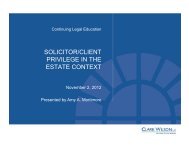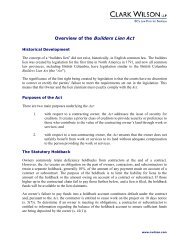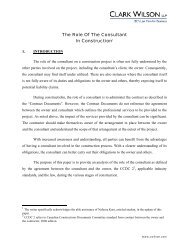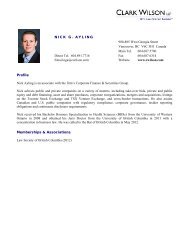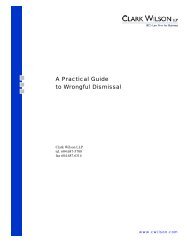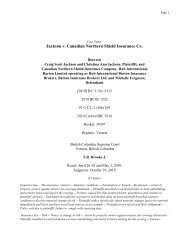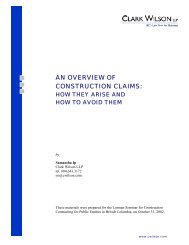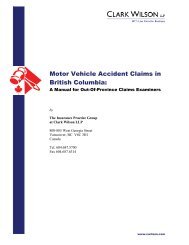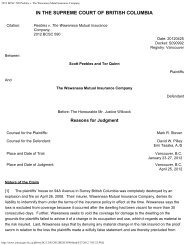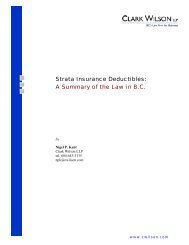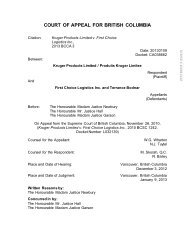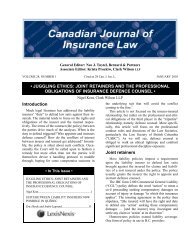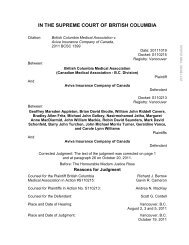juggling ethics: joint retainers and the ... - Clark Wilson LLP
juggling ethics: joint retainers and the ... - Clark Wilson LLP
juggling ethics: joint retainers and the ... - Clark Wilson LLP
You also want an ePaper? Increase the reach of your titles
YUMPU automatically turns print PDFs into web optimized ePapers that Google loves.
p. 10<br />
<br />
<br />
<br />
<br />
<br />
if <strong>the</strong> lawyer is not appointed to represent <strong>the</strong> insured alone (which is rarely <strong>the</strong> case in most<br />
situations), <strong>the</strong>n <strong>joint</strong> representation of both <strong>the</strong> insurer <strong>and</strong> insured is permissible “with<br />
appropriate disclosure in accordance with Chapter 6 of <strong>the</strong> Professional Conduct H<strong>and</strong>book”;<br />
in any such <strong>joint</strong> retainer, “<strong>the</strong> lawyer has duties to both <strong>the</strong> insured <strong>and</strong> <strong>the</strong> insurer”, <strong>and</strong> must<br />
take care to identify <strong>and</strong> avoid conflicts of interests between <strong>the</strong> two clients;<br />
“so long as <strong>the</strong> insured is a client, <strong>the</strong> Rules of professional conduct‐<strong>and</strong> not <strong>the</strong> insurance<br />
contract‐govern <strong>the</strong> lawyer’s obligations to <strong>the</strong> insured”;<br />
“if, after commencing to act on a <strong>joint</strong> retainer, <strong>the</strong> lawyer receives information that evidences a<br />
conflict between <strong>the</strong> insured <strong>and</strong> <strong>the</strong> insurer, <strong>the</strong> lawyer must withdraw from <strong>the</strong> <strong>joint</strong><br />
representation without disclosing <strong>the</strong> information giving rise to <strong>the</strong> conflict”; 17<br />
“where <strong>the</strong> policy of insurance authorises <strong>the</strong> insurer to control <strong>the</strong> defence <strong>and</strong> to settle within<br />
policy limits in its sole discretion, <strong>the</strong> lawyer must inform <strong>the</strong> clients of those limitations on <strong>the</strong><br />
representation”. After <strong>the</strong> lawyer has communicated <strong>the</strong> necessary information respecting<br />
<strong>the</strong>se limitation to <strong>the</strong> insured, “<strong>the</strong> lawyer may settle at <strong>the</strong> direction of <strong>the</strong> insurer”<br />
(presumably even though <strong>the</strong> insured may object).<br />
It will be noted that <strong>the</strong> October 2008 Bulletin did not address <strong>the</strong> situation where <strong>the</strong> liability insurer is<br />
defending, <strong>and</strong> <strong>the</strong> defence counsel is appointed, pursuant to a “reservation of rights” or non‐waiveragreement<br />
scenario (for example, where claims may or may not be covered depending on <strong>the</strong> outcome<br />
of <strong>the</strong> case). The staff <strong>ethics</strong> lawyer for <strong>the</strong> LSBC takes <strong>the</strong> view that “independent legal advice is<br />
necessary for <strong>the</strong> <strong>joint</strong> clients in <strong>the</strong>se situations”. If so, it is presumably incumbent upon <strong>the</strong> defence<br />
lawyer to ensure this issue is addressed when <strong>the</strong> “Chapter 6 letter” is issued to <strong>the</strong> insured at <strong>the</strong><br />
outset of <strong>the</strong> retainer.<br />
MARA V. BLAKE: DOES CONTRACT TRUMP PROFESSIONAL CONDUCT CODES?<br />
In Mara v. Blake (1996), 23 BCLR (3d) 225 (CA) <strong>the</strong> hapless plaintiffs were involved in four different<br />
motor vehicle accidents over a span of four years. They issued four separate lawsuits against <strong>the</strong><br />
various motor vehicle defendants, all of whom were insured by ICBC. The insurer appointed <strong>the</strong> same<br />
lawyer to act as defence counsel for <strong>the</strong> various owners/operators who had been named as defendants.<br />
Liability was admitted in three of <strong>the</strong> law suits, although contributory negligence was alleged. In one of<br />
<strong>the</strong> actions, liability was denied.<br />
All four actions were ordered to be tried toge<strong>the</strong>r but at <strong>the</strong> commencement of <strong>the</strong> trial, <strong>the</strong> Judge<br />
raised concern about defence counsel being in a position of conflict in acting for all four groups of<br />
defendants. The Judge felt it would be necessary for four different counsel to appear for each group of<br />
defendants unless <strong>the</strong> insurer, ICBC, was prepared to ab<strong>and</strong>on <strong>the</strong> contributory negligence allegations<br />
<strong>and</strong> appoint separate counsel in <strong>the</strong> one action where liability was denied. ICBC refused <strong>and</strong> <strong>the</strong> trial<br />
17 The most common example of this is where <strong>the</strong> insured discloses information to <strong>the</strong> lawyer which places or may<br />
place <strong>the</strong> insurance coverage in jeopardy (“I drank 8 beer before I got into <strong>the</strong> car to drive”, “it wasn’t an accident<br />
… I meant to hurt him”)<br />
© 2009 <strong>Clark</strong> <strong>Wilson</strong> <strong>LLP</strong> cwilson.com<br />
Nigel P. Kent, T. 604.643‐3135.



